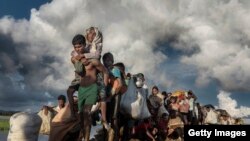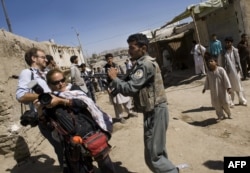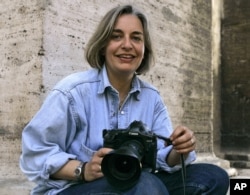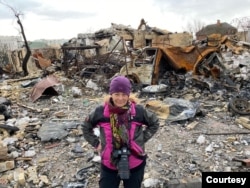Their feet caked in mud, a line of Rohingya refugees crosses a rice field. A young man, wearing only a thin pair of green shorts, carries an exhausted woman on his back.
The moment, captured in Palong Khali, Bangladesh, on Oct. 9, 2017, is just one of many images taken by American freelance photojournalist Paula Bronstein during her 40-year career.
Bronstein has spent decades reporting from some of the most dangerous areas in the world, covering migrants fleeing to safety and the aftermath of natural disasters and war. Work that earned her the International Women's Media Foundation Anja Niedringhaus Courage in Photojournalism Award.
"I'm a photographer that wants to make sure the world sees what's going on," Bronstein told VOA.
For 20 years, that meant working in Afghanistan, where Bronstein documented everyday life from the start of the war in 2001 until February of this year.
In 2016, she published Afghanistan: Between Hope and Fear, a photo essay of women and children she met during that period, and her work covering poverty, addiction and the effects of war.
When the Taliban took over Kabul in August 2021, Bronstein says she felt she had to evacuate.
"We didn't know, as female journalists, how we were going to be treated, whether we would be arrested, what was going to happen," Bronstein told VOA.
But having covered daily life in Afghanistan for so long, she felt compelled to return.
"I went back as soon as possible," she said, returning just a few weeks after the takeover to record daily life as conditions worsened, especially for women.
Bronstein remained in Afghanistan until February, when she left to document Russia's war in Ukraine — an experience she says is unlike anything else she has come across.
"It has to do with understanding where your safety of work is," Bronstein told VOA. Russia's widespread use of shelling has made it harder for journalists to protect themselves.
Russia has been accused by international bodies and the media of indiscriminate shelling, including of civilian areas.
In that environment, Bronstein said, "You have to understand that and know that the only thing you can do to protect yourself is just to really, really be cautious."
The Committee to Protect Journalists (CPJ) reports at least 12 journalists have been killed while covering the war in Ukraine. The press freedom nonprofit is examining the circumstances in which several others died, to determine if the deaths are journalism-related.
Decades of coverage
It is Bronstein's commitment and willingness to stay the course, despite the danger, that led the IWMF to award her the 2022 Anja Niedringhaus Courage in Photojournalism Award.
The award is presented in memory of Associated Press photographer Niedringhaus, who was killed in 2014.
"Paula has been engaging in some of the most difficult photojournalism and documentation work in the world for decades," Elisa Lees Muñoz, executive director of the IWMF, told VOA. "And, similar to Anya, she has dedicated her career to going to record these difficult scenes in a way that really focuses on the humanity of her subjects and on the beauty around her in these awful, awful circumstances."
For Bronstein, it isn't just about war. She is interested in how people adapt during conflict.
In Ukraine, she documented life backstage with the Lviv Ballet as a relative normalcy returned despite ongoing fighting elsewhere in the country.
"That's something I did for many years in Afghanistan — documenting the resilience of people living against a backdrop of war," Bronstein said.
Niedringhaus also spent decades photographing the impact of conflict.
While covering the Balkans, a sniper in Sarajevo shot at her; in Kosovo, a grenade blast ejected her from a car; and in 1991, she and a group of journalists had a near miss when NATO forces mistakenly bombed the area they were in along an Albanian border.
Niedringhaus won the IWMF Courage in Journalism award in 2005, the same year the Pulitzers honored her for coverage of the war in Iraq.
For Bronstein, winning an award named in Niedringhaus' memory was especially meaningful because she knew her. Both photojournalists were in Afghanistan in 2014. That same year, an Afghan policeman opened fire on a parked vehicle Niedringhaus was in.
Bronstein described her colleague's death as "a huge challenge," adding, "That's what always happens with war: You think it's safe until it's not."
Alongside Bronstein, the IWMF awarded honorable mentions to two other photojournalists: Farzana Wahidy, an Afghan covering her home country, and Carol Guzy, an American who has previously won accolades for work in Haiti, Kosovo and Iraq. Guzy, like Bronstein, is also reporting from Ukraine.
Though hesitant to say the work of these journalists is any different from that of their male colleagues, Muñoz says that women are able to cover places and situations that men cannot access, such as the communities Bronstein photographed in Afghanistan.
Charlotte Fox, IWMF director of communications, elaborated, telling VOA, "So many communities' stories aren't in mainstream narratives because there's been a lack of effort to engage with those communities, embed with those communities, and those communities don't see themselves in the journalist who is reporting the story.
"And that's exactly why women and non-binary journalists are so critical as folks who tell these stories, because it might be their own lived experience, it might be their own community that they're able to tap into and access and speak with," Fox said.
Bronstein and Guzy began working as photojournalists in the 1980s, at a time when the industry was dominated by men, especially the war beat. Muñoz says the two "paved the way for their peers today to be part of the profession."
The IWMF didn't make a conscious decision to recognize the age of Bronstein and Guzy, but Muñoz is glad to bring attention to veteran photographers.
She noted that in a competitive industry, some outlets look for what she said is "the cheapest and easiest way to get those images instead of the most meaningful and most in-depth way."
Bronstein has also found that to be the case. Still, despite the challenges of the industry and the risks of being out in the field, she can't imagine a different career.
"I love what I do and if I didn't, there's no way I could maintain it, absolutely no way," Bronstein said. "It totally feeds me. It's like oxygen."







